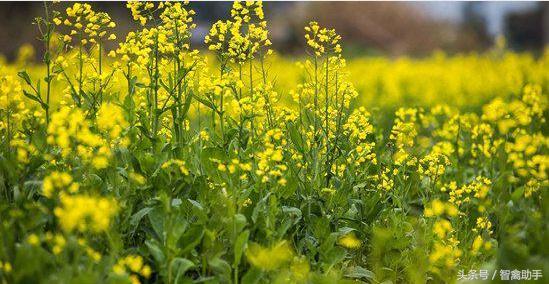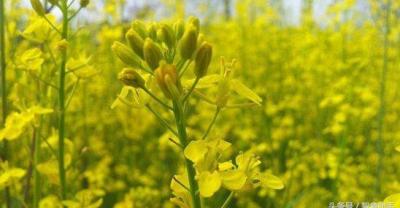How to grow rape?
Rape is one of the favorite vegetables, which is crisp and nutritious. At the same time, rape also has the effects of reducing blood lipids, detoxification and detumescence, beauty and health care. In recent years, as people pay more and more attention to health, rape with certain health care effect is also very popular and has high planting value. Therefore, rape cultivation has also attracted many farmers and become a rich vegetable. So, how to grow rape? The planting technology and management of rape are introduced as follows.

Picture: rape planting
I. planting techniques of rapeseed
1. Selection of improved varieties: according to the local cultivation system and climatic conditions, combined with the local soil fertility level and production situation, select varieties with strong stress resistance and high yield.
two。 Make a good seedbed: the seedbed should be ventilated and sunny, the soil is fertile and loose, the plot close to the water source, and the soil preparation is fine. Seedbed preparation is required to be "flat", "fine" and "solid".
3. Sowing at the right time: rape is very sensitive to sowing time. Therefore, determining the sowing date is an important issue in the cultivation of rape. Rape sprouting and rooting and long leaves all need certain temperature conditions. The optimum temperature for germination needs 16-22 ℃ per day, and the leaf emergence of seedlings needs more than 10-15 ℃. In addition, it is also necessary to ensure that there is at least 40-50 days of effective growth period after transplanting before entering the overwintering.

Picture: rape planting
4. In fertilizer operation, we should grasp the principle of "front promotion, middle control and post stability". On the basis of applying sufficient base fertilizer before sowing, the three-leaf stage combined with fixed seedlings and good seedling fertilizer, generally 20-30 piculs of water and manure per mu or 2-3 kg of urea per mu to promote leaf opening and seedling emergence. 5-6 days before transplanting, 7.5 kg urea per mu was applied as starting fertilizer, which was beneficial to early seedling development after planting. Timely prevention and control of diseases and insect pests, aphids and cabbage insects are the main pests in rape seedling field, and timely drug control should be used. At the same time, weeds around the seedbed should be removed in order to reduce insect sources, and "stand-up medicine" should be fully used 3-4 days before transplanting to prevent pests from entering the field.
5. The application of sufficient base fertilizer: rape plant is tall and needs a lot of fertilizer, so we should pay attention to the application of base fertilizer, insufficient base fertilizer and thin seedlings, which will affect the plant growth and even the economic yield of rape. The base fertilizer is mainly organic fertilizer, supplemented by chemical fertilizer, which lays a good foundation for rape to need fertilizer all its life. Generally, 2000 kg of organic fertilizer, 45% of general compound fertilizer 25-30 kg or 36% of compound fertilizer (15-10-11) 30-40 kg and boron fertilizer 0.5-1 kg are applied per mu. Application method: combine ploughing and ploughing and deep application of organic fertilizer, compound fertilizer and boron fertilizer, do not fertilize too shallow, so as not to cause rape to lose fertilizer in the middle and later stage.
6. Timely transplanting: reasonable close planting, seedling age 30-35 days, green leaves 5-6, root thickness 5-6 mm, strong seedlings with soil, fertilizer, medicine transplanting, do not plant high-foot seedlings, curved-foot seedlings, thin disease seedlings. Transplanting specification 50cm × 20cm, planting about 7000 plants per mu, transplanting while covering soil, watering root water in time after transplanting, checking deficiency and replenishing seedlings 3 days after transplanting.

Picture: rape planting
II. Planting management of rape
1. Seedling fertilizer: early application, frequent application of seedling fertilizer, timely supply of nutrients needed for rape seedling stage, the use of a short period of higher temperature before winter to promote the growth of rape, to achieve strong seedlings overwintering, and lay the foundation for high and stable yield of rape. Seedling fertilizer can be divided into early seedling stage and late seedling stage. The fertilizer in the early stage of seedling is applied when the seedling is fixed or 5 true leaves, generally applying 5-6 kg urea per mu, in the soil lacking phosphorus and potassium, if the base fertilizer is not applied phosphorus and potassium fertilizer, phosphorus and potassium fertilizer should be applied; topdressing in the later stage of seedling should depend on seedling condition and climate. Generally, 8-10 kg of high nitrogen compound fertilizer is applied per mu. The varieties with strong spring or the warmer areas in winter should be applied early, and the low temperature in winter or triple-cropping rape should be applied late.
two。 Bolting fertilizer: the bolting stage of rape is the period of vegetative growth and reproductive growth, with rapid bolting, long branches, increased leaf area and large differentiation of flower buds, which is not only the most fertilizer period, but also the key period of increasing branches and pods. Therefore, bolting fertilizer should be applied steadily according to the application and growth of base fertilizer and seedling fertilizer. Basal and seedling fertilizer is sufficient, plant growth is robust, and bolting fertilizer can be applied little or not; if basal and seedling fertilizer is insufficient, bolting fertilizer should be applied early if there is a tendency to de-fertilize. Generally, 15-20 kg of high nitrogen compound fertilizer is applied per mu. Fertilization time is generally in the middle of bolting, bolting height of 15-30 cm is better. But those with weak growth can be fertilized at the initial stage of bolting to avoid premature senility; those with strong growth can be applied at the later stage of bolting, when the bolting height is 30-50 cm, so as not to cause canopy caused by excessive growth during flowering.
3. Flower fertilizer: rape blossoms and pods after bolting, and the number and weight of seeds are closely related to the nutritional conditions after flowering. For vigorous growth, large amount of fertilizer can not be applied or less applied at bolting stage; no fertilizer is applied to early-maturing varieties, or less at the initial flowering stage; topdressing at flowering stage can be foliar spraying, and 0.1-0.2% urea or 0.2% potassium dihydrogen phosphate is sprayed at flowering and podding stage. In addition, 0.2% borax aqueous solution can be sprayed once in the late seedling stage and bolting stage to prevent the phenomenon of "flowering but unfruitful" and increase the yield.
4. Rape has a long growth period, large nutrition, luxuriant leaves, many fruiting organs, and a large amount of water in its lifetime. Rape producing areas generally have less rainfall in autumn, winter and spring, and the soil is dry, which is not conducive to sowing seedlings and cultivating strong seedlings. The winter drought in the northern region often aggravates the frost injury and causes dead seedlings. There were more Rain Water in the southern region in the later period, resulting in waterlogging or waterlogging damage. Therefore, according to the characteristics of water demand of rape, irrigation and drainage should be carried out in time according to local conditions.

Picture: rape planting
5. Scientific sharpening: forty-five and fifty days after transplanting, rape should be tapped when buds appear at the top of the plant, so as to promote rape to produce more sturdy primary branches, form a good population structure, and obtain the best yield. The buds should be removed manually at the growth stage before bolting and bolting, and the plant has 8 leaves after tapping. Early bud differentiation is not completed, insufficient growth, which is not conducive to rape growth, too late, rape has been bolting, can not form a good population structure, easy to form high node branches, easy to break and lodge in the later growth stage.
6. Pest control: the main diseases and insect pests harmful to rape are cabbage insect, jumping beetle, aphid, cotton bollworm, etc. for the damage of cabbage insect, jumping beetle and aphid, 25% enemy killing 3000 times liquid or 40% dimethoate 1000 times liquid can be used to control the damage of cotton bollworm. in the stage of low-instar larvae, 40g / mu plus Wanling 20g was sprayed with water every 5 minutes and 7 days, spraying 23 times.
7. Timely harvest: rape should be harvested at the right time, the harvest is too early, the pod is not mature, the harvest is too late, the pod is too ripe, the shell is easy to burst, the seeds are scattered, resulting in waste, the pod is in the yellow ripening stage, that is, the pod of the whole plant is yellow, which is the best time for rape harvest, at this time, the highest oil content and yield of rape can be obtained.
[conclusion] rapeseed contains a variety of nutrients with high nutritional value, and it is still a good edible vegetable oil with high planting value. The planting technology and management of rape have been introduced to you above. Have you learned it?
- Prev

Planting skills of hibiscus flower
Hibiscus flower is a kind of small shrub, which is loved by the majority of flower friends because of its large and colorful flowers. Indoor farming can be evergreen all the year round and bloom. Hibiscus has many colors and is common.
- Next

Rape planting steps
To select improved varieties, we should choose varieties with high quality, disease resistance, high yield and bolting tolerance, such as Xiaogui, Huaguan, Jinglu No.2 and so on. Under the general condition of applying sufficient base fertilizer, the mu is superior to others.
Related
- Fuxing push coffee new agricultural production and marketing class: lack of small-scale processing plants
- Jujube rice field leisure farm deep ploughing Yilan for five years to create a space for organic food and play
- Nongyu Farm-A trial of organic papaya for brave women with advanced technology
- Four points for attention in the prevention and control of diseases and insect pests of edible fungi
- How to add nutrient solution to Edible Fungi
- Is there any good way to control edible fungus mites?
- Open Inoculation Technology of Edible Fungi
- Is there any clever way to use fertilizer for edible fungus in winter?
- What agents are used to kill the pathogens of edible fungi in the mushroom shed?
- Rapid drying of Edible Fungi

